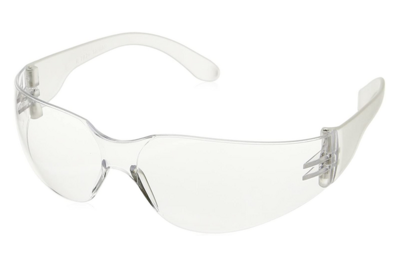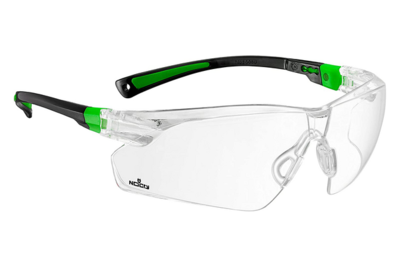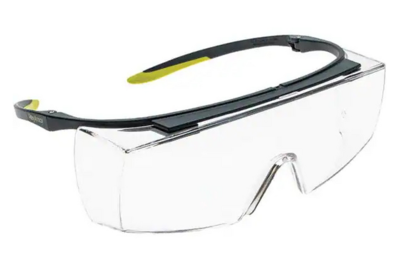
By James Austin
James Austin is a writer covering games and hobbies, which means he is in a constant cycle of learning board games and teaching them to people.
Safety glasses are standard stock at metal shops and construction sites. But they are also helpful for countless activities around the home—from dusting a high shelf to weeding—that can send errant debris flying directly into your delicate eyes. A good pair of safety glasses will protect your peepers and be comfortable to wear, but the best pair is a lot like the best face mask: It’s the one you’ll actually use regularly and not fuss with. After researching and testing 27 pairs of safety glasses, and consulting with an ophthalmologic surgeon, a professional racquetball player, and dozens of robot builders, we think the Radians MR0111ID Mirage is the pair most people will wear most of the time. If you already wear prescription glasses, the HexArmor LT250 will be the least distracting over your frames.
Everything we recommend
Our pick
Our panel of testers found these safety glasses to be the lightest and most comfortable to wear. And at about $2 a pop, they’re easily replaceable if lost or damaged in the line of duty.
Buying Options
Upgrade pick
You can adjust the length and angle of the arms and nose bridge on this pair, so there’s a good chance of getting a perfectly personalized fit.
Buying Options
Our pick
The HexArmor LT250 fit well over our testers’ glasses, and this pair stayed in place better than any other over-glasses options.
Buying Options
Our pick
Our panel of testers found these safety glasses to be the lightest and most comfortable to wear. And at about $2 a pop, they’re easily replaceable if lost or damaged in the line of duty.
Buying Options
Among the lightest and cheapest safety glasses we tested, the Radians MR0111ID Mirage pair surprisingly offered some of the best protection and comfort. Even though the “one size fits most” design doesn’t offer any adjustment options, this pair’s extremely flexible arms allowed them to fit a wide range of head sizes. And a number of our testers barely noticed they were wearing these glasses after the first few minutes.
Advertisement
SKIP ADVERTISEMENTUpgrade pick
You can adjust the length and angle of the arms and nose bridge on this pair, so there’s a good chance of getting a perfectly personalized fit.
Buying Options
If you find that “one size fits most” doesn’t work for you, the NoCry Safety Glasses allow for much more adjustment. They also come in a few different color options and provide coverage that’s a bit snugger (with less space between the skin and the glasses) than our main pick.
Our pick
The HexArmor LT250 fit well over our testers’ glasses, and this pair stayed in place better than any other over-glasses options.
Buying Options
For those who already wear prescription eyeglasses and want to protect their lenses from unnecessary scratches, the HexArmor LT250 over-glasses pair provides an encompassing fit without interference.
Advertisement
SKIP ADVERTISEMENTWhy you should trust me
My history—and general annoyance—with bad safety glasses goes back to my high school years, when I was a member of a FIRST Robotics team (a competitive robotics building program that requires you to wear safety glasses for multiple hours, often for several days in a row). As a result, I’ve been informally testing various types of safety glasses for years in an attempt to find a pair that I wouldn’t end up hating after a four-day-long competition.
I also talked with Chris R. Alabiad, a reconstructive eye surgeon and an associate professor of clinical ophthalmology at the University of Miami Miller School of Medicine, about the things safety glasses are likely to protect you from and what can go wrong when foreign particles get into your eyes. In addition, I spoke with Paola Longoria—the number-one-ranked player on the Ladies Professional Racquetball Tour and the International Racquetball Federation’s three-time world champion in women’s singles—about common grievances over how safety glasses fit and stay on your face while you’re active. (Full disclosure: Longoria has an endorsement deal with Oakley, but this company didn’t make it into our test panel due its glasses’ significantly higher cost than most.)
Who this is for
Almost everyone will encounter a situation where they should really wear eye protection. This is true for everything from yard work to sports to basic household chores. “Any activity that you take part in where something can inadvertently get in your eye is an activity in which you want to wear glasses,” Alabiad told me when we talked. When foreign particles get into an eye, they can damage the sensitive membranes of your eyeball, leading to irritation, light sensitivity, and infection. According to the National Institute for Occupational Safety and Health, each day about 2,000 US workers sustain eye injuries that require medical attention.
Most safety glasses are made from polycarbonate (a strong material widely used in all types of lenses and protective equipment due to its high shatter resistance) and are designed to keep everything that might come flying at your face away from your sensitive eyes. Sunglasses or eyeglass lenses made from glass or plastic are occasionally helpful for this, but, unlike polycarbonate, these elements risk shattering and causing more problems since the shards can scratch or become embedded in the eyeball.
Safety glasses are useful pieces of safety equipment for a number of sports too. “You can have blunt traumas,” Alabiad said, which can bruise the eye directly or damage the protective bone structures around the eye. “Like if you’re playing basketball and someone elbows you. A pair of protective lenses can be quite useful to keep your eye protected.” In fact, basketball is the leading cause of sports-related eye injuries, according to the American Academy of Ophthalmology, usually from players inadvertently poking other players in the eye and causing unpleasant-sounding injuries like retinal detachment. Kareem Abdul-Jabbar notably started wearing goggles during games after his cornea was scratched more than once early in his career. (He told the Los Angeles Times, “I remember a couple of times I could hear the click of somebody’s nails on my glasses and I knew I was doing the right thing.”) In racquetball player Longoria’s sport, safety glasses are a requirement. During a serve, a racquetball can fly at more than 100 miles per hour, and, as she pointed out, “you could lose your vision.”
Advertisement
SKIP ADVERTISEMENTHow we picked and tested
Any time you are looking for protective equipment, you want to know it’s been tested and approved by an independent agency and rated for the activity you plan to use it for. For this guide we focused on glasses that had at least achieved either an American National Standards Institute (ANSI) Z87.1+ (PDF) rating (which specifies that the glasses will, among other things, protect against small particles traveling up to 150 feet per second) or the similar European Standards EN 166-1F (PDF) rating (which specifies that the glasses will protect against small particles traveling up to 45 meters per second, or 147.6 feet per second).
We wanted to find glasses that would cover a wide number of circumstances most people might come across on a day-to-day basis in such realms as home and lawn care, recreation, crafts, and hobbies. In addition to researching the best-selling pairs on Amazon and those recommended by other review sites, I checked in with my fellow FIRST Robotics participants to get suggestions on some of their favorites.
We also considered the look of any potential glasses. Style may not be the most important thing about protective equipment, but if you like the way you look in a pair, you’ll be more likely to wear them—and consequently more protected. Longoria admitted to taking fashion into consideration when it comes to her safety glasses, but she said that “in the end you need only to protect the eye.”
Once we had a good list of potential models, I obtained 17 of the most promising pairs to try out myself. In this initial testing I wore each pair for at least 30 minutes, judging them for comfort, as well as for potential issues like fogging, while going about my normal day. I also used them while doing basic household projects like hanging pictures and installing wall storage panels in my new apartment (if my landlord is reading this, don’t worry, I have a plan to fill in the holes in the walls). Despite its shatter resistance, polycarbonate is prone to scratching. So I scraped the left lens of each pair with a nail while using a kitchen scale to maintain a consistent pressure between 1½ and 2 pounds (this was not scientific, but I tried my best) to see how the marking would affect visibility.
When I had an idea of which pairs were likely the most effective, I organized a panel of nine Wirecutter staffers (and, in some cases, their significant others) to test a selected group of four each themselves. We asked for a broad spectrum of volunteers and looked for a variety of head sizes (both large and small), nose bridges of varying widths, different distances between eyes, size variety in ears, and more. We ended up with a diverse group representing a range of genders, ethnicities, and ages. And during the panel testing, our team worked on projects ranging from desoldering mechanical keyboards, using a wire wheel to buff up and restore an old bench vise, using a rotary tool to sand down 3D prints, cutting up firewood with an axe and a chainsaw, and simply wearing the glasses around the house. One tester even hit his pairs with a replica Red Ryder BB gun to see whether they’d offer as much protection as Ralphie’s glasses in A Christmas Story (video), or if, indeed, you’d shoot your eye out. This was admittedly an unfair test (since the air rifle blasts BBs at 350 feet per second, a significant speed impact increase over what our picks were independently tested to withstand), but we were pleasantly surprised by the results.
Our pick: Radians MR0111ID Mirage

Our pick
Our panel of testers found these safety glasses to be the lightest and most comfortable to wear. And at about $2 a pop, they’re easily replaceable if lost or damaged in the line of duty.
Buying Options
We were thrilled that the pair with the highest comfort rating from our panel was also among the cheapest pairs we tested. The Radians MR0111ID Mirage glasses offer the best combination of wearability, convenience, and basic protection. Despite this pair’s all-plastic build (aside from the polycarbonate lenses) and very little in the way of features, the Radians stood out for being light and clear enough that a number of our testers forgot they were wearing them. One tester spent close to five minutes looking for them before realizing they were still on his face.
The “one size fits most” claim is common among cheaper safety glasses, but the Radians were one of the few models that actually delivered on that front. Lacking any sort of adjustments, the Radians still fit well on almost all of our testers’ faces, with one tester noting that this pair worked well for both her and her nearly 5-year-old daughter without any shifting or sliding. (It’s important to note, however, that all of the glasses we tested are meant for adults only. We were just curious how they’d fare on a smaller noggin.) The thin plastic arms flex easily to accommodate various head shapes and sizes without putting undue pressure on the temples (which a few of the other pairs we tested and ruled out did), but the Radians still maintained enough grip to not slide around the face while working. At their tips, each arm flexes 10 inches from the center of the nose bridge, which measures 1¼ inches at its widest point.
The lenses remained clear and had very little fogging during our tests. They didn’t gather many scratches during normal use. But after we put them through the deliberate scratch test and bounced multiple BBs off the lenses, the scuffing was noticeable enough to distort the view. Even so, because of the Radians’s low cost, you’d have to go through a number of pairs before the price became comparable to the prices of our other picks.
The glasses look streamlined on a face, with a wrap-around style that protects the side of your eyes and gives the wearer a sleek look (sort of a clear version of Doc’s safety glasses in Back to the Future II, but cooler). You can get the Radians in a number of different color tints, but if you do opt for any of the non-clear options, make sure they’re appropriate for the kind of work you plan to perform while wearing them. Darker shades may be great for things like yard work or outdoor sports, but the tint may affect indoor visibility to an unsafe degree.
The Radians fit well on most of our testers’ faces, but not all. And the glasses’ lack of adjustments means that if they’re not a match, they’ll be an annoyance the whole time you wear them. Luckily they’re cheap enough that if you find they don’t work for you, you didn’t spend that much, and you can gift or donate them.
We also noticed that the gap at the bottom of the glasses was a little wider than that of some other glasses we tested, though this didn’t cause a problem in our testing. No debris got in through those gaps, even during the tsunami of unpredictable projectiles from chores like cutting wood with a chainsaw.
Advertisement
SKIP ADVERTISEMENTUpgrade pick: NoCry Safety Glasses

Upgrade pick
You can adjust the length and angle of the arms and nose bridge on this pair, so there’s a good chance of getting a perfectly personalized fit.
Buying Options
If you find that the Radians’s “one size fits most” design doesn’t suit you, the NoCry Safety Glasses have a number of adjustment points at the arms, arm joints, and nose bridge to help them fit better on your face, allowing you to wear them for longer without their becoming an annoyance.
The NoCry glasses offer slightly more coverage than the Radians, specifically around the bottom of the glasses. The frames have two points of adjustment to help them fit better on different faces, a three-position slider for arm length, and a four-position tilt to adjust the angle of the arms. The nose bridge (which is a soft, flexible but firm rubber material that keeps the pair snug) can also be rotated in and out for a tighter or wider fit.
These adjustments may not be necessary for most people, but if you find that a lot of safety glasses end up being uncomfortable on your face, these offer a better chance of finding a fit that works well. One of our testers was surprised at how much of a difference even small adjustments made, specifically the angle of the arms. And another noted that the adjustments meant this pair was able to fit snugly on varying head sizes (hers, her partner’s, and their young child’s). At the tip, each arm flexes 8½ inches from the center of the adjustable nose bridge.
The nail-scratching test left visible marks on the lenses, which you could see when looking at them. But the scratches didn’t cause any sight issues while we were wearing the glasses, and the lenses fared similarly after being hammered with BBs. Slight scuffs were visible on the outside of the lens, but they didn’t impede vision; it became an issue only after we subjected the glasses to repeated pummeling. The frames come in a variety of colors, though availability may be spotty at times, and you can get them with clear or tinted lenses.
As for flaws, the arms of the NoCry glasses aren’t as outwardly flexible as those of the Radians, which means that they’ll likely put a bit more pressure behind the temples. One of our testers noted that the colored textured plastic at the ends of the arms, designed to keep the arms from slipping around, tended to catch on and pull at his hair when he tried to take them off in between tasks.
Our pick for wearing over prescription lenses: HexArmor LT250

Our pick
The HexArmor LT250 fit well over our testers’ glasses, and this pair stayed in place better than any other over-glasses options.
Buying Options
If you already wear eyeglasses, it’s still important to remember your safety glasses, not only for protection but also to prevent your prescription lenses from getting scratched. Our testers liked the HexArmor LT250 glasses because they fit securely over their current pairs and consistently stayed put on various head sizes and shapes—from someone who wore a small hat size to another who wore an extra-large. At its widest, the nose bridge reaches 1½ inches, and each arm bends outward 8½ inches from the center. This pair also offered the most complete protection, compared with other over-glasses pairs we tested.
The HexArmors don’t have any adjustments, but our testers all said these glasses still felt secure on their faces, and they didn’t report having any issues with the pair sliding down their noses as they looked down at projects. The HexArmors also seemed to completely enclose their prescription glasses, without bumping into or rubbing against them. One tester noted that this pair’s extra coverage on the bottom felt safer than the bits of space on other pairs we tested.
These glasses don’t have any frame-color options, though there is a pair with a slightly tinted lens that, along with the boxy shape, makes the wearer look a bit like an extra from a cyberpunk science-fiction film.
In addition to lacking adjustments, the frame of the HexArmor seems a bit flimsy, though we didn’t encounter any issues with this during our testing. We’ll see how they hold up in our long-term testing.
Advertisement
SKIP ADVERTISEMENTThe competition
The 3M Virtua CCS safety glasses have a removable foam gasket around the inside of the frame that’s designed to both make them more comfortable and to form a more complete seal around the eyes. The foam was polarizing among our testers: Some liked the added protection during tasks that cause a high amount of small particles to be thrown into the air, but others found it restricted their peripheral vision too much. We also ran into fogging issues, which led us to dismiss this pair as a pick.
We looked at a few different pairs from Bollé, after they kept coming up in our research, including the Safety RUSH+ 41080, the Contour Metal, and Override over-glasses pair. We liked that the Rush+ came with a strap that kept the glasses secure, but the foam gasket was a mixed bag, and it isn’t removable like the one on the 3M pair. The Contour Metal was a nice-looking pair, but it was too heavy to reliably stay on my face, and the Overrides were too bulky and stiff compared with the other over-glasses models we tested. We also wanted to test the Bollé Safety 40306 over-glasses pair, which looked much less boxy than the other over-glasses options we tested, but they’ve been discontinued.
The Bouton 5900 safety glasses have a traditional hipster look, which might be appealing to some folks, but we found them to be too heavy on the face, and the folding mesh side shields were just textured enough to be noticeable and annoying in peripheral vision.
We tested a few goggle-type glasses for this guide, including a pair from DeWalt, Products Simplified, and Protective Equipment, but we found they were more than what most people need on a usual basis.
A cheap over-glasses option that has a good history of reviews on Amazon, the Gateway Safety 6980, just didn’t perform as well as the HexArmor pair, and they tended to rattle and rub up against our testers’ prescription glasses.
After looking into the HexArmor over-glasses, we also tried out their VS250 option. They’re a decent lightweight pair, but they tended to slip down the nose more than the Radians and didn’t have any adjustments to help counteract that shortcoming. Of the models we considered, they do look the most like normal sports sunglasses, and they come with a variety of lenses, including some that transition from tinted to more translucent (but those are more expensive).
In the hopes of finding something similar to the style of Ray-Bans or the cheap sunglasses we like, we tried out the MAGID Y50BKAFC, but all of our testers thought they were stiff and uncomfortable. Also, the thick frames and stiff boxy design leave a lot more space open around the eye while also blocking visibility, making this sort of a worst-of-all-worlds option.
The MCR Safety Crews BearKat glasses are a common sight at robotics competitions due to their affordability and availability, but we liked the Radians far better in terms of comfort.
Like our upgrade pick, the NoCry Over-Glasses pair offered a decent amount of adjustment options, but our testing panel preferred the HexArmor pair due to its more complete coverage and better fit.
We liked that the OnGuard Plano Trophy Safety Glasses seemed to provide good coverage and a few adjustment options, and that they come with a unique Velcro strap to help secure them to your face. But despite the adjustment options, our testers all found them uncomfortable to wear, with many complaining about the weight and how the nose bridge pinched their skin.
We also looked into the safety glasses offered by specialty companies like Oakley, which came up a few times in my discussion with robotics competition participants. But we ended up ruling them out of this testing due to their significantly higher price points. There are plenty of safety glasses that work extremely well without coming anywhere close to $140.
Meet your guide
James Austin is a staff writer currently covering games and hobbies, but he’s also worked on just about everything Wirecutter covers—from board games to umbrellas—and after being here for a few years he has gained approximate knowledge of many things. In his free time he enjoys taking photos, running D&D, and volunteering for a youth robotics competition.
Further reading
The Best Extension Cords for Your Home and Garage
by Doug Mahoney
The U.S. Wire & Cable 50 FT. Extreme All-Weather Extension Cord is the most flexible, durable cord we found, and should last years even in harsh environments.
Our Favorite Baby-Proofing Tools
by Wirecutter Staff
Once babies become mobile, they can get themselves into all kinds of trouble. These are our favorite tools for baby-proofing our homes.
The Best Kids Cooking Tools (That You’ll Love Too)
by Lara Rabinovitch
We’ve tested more than 45 pieces of kitchen gear to find those that are most worth investing in for younger cooks, whether they’re toddlers or teens.
The Fire Extinguisher, Smoke Detector, Carbon Monoxide Detector, and Other Safety Essentials You Need in Your Home
by Cey'na Smith
Here’s what you need at home to prepare for seriously bad (but entirely plausible) scenarios.
Advertisement
SKIP ADVERTISEMENT







